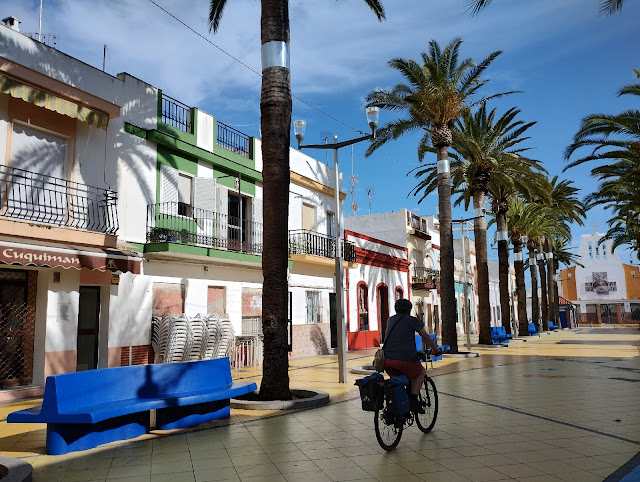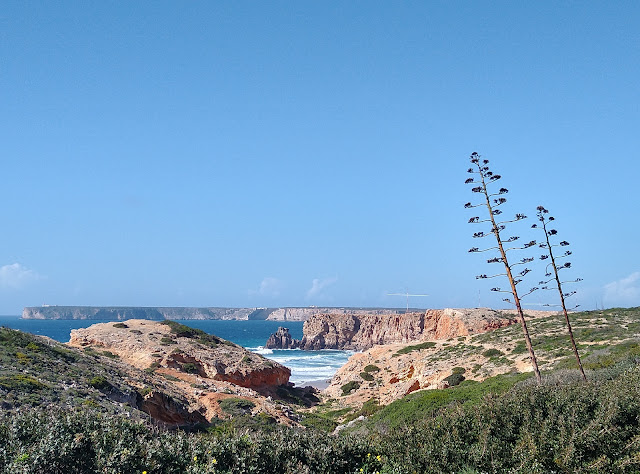Though we stayed for a week in Isla Cristina we didn't manage to visit the town centre until our final day. The blustery weather made it a less than alluring prospect. We should probably have made the effort as our stay coincided with carnival week. We heard the celebrations in the distance from time to time, and today, when we finally made the effort to pedal into the town centre centre to find an ATM, the long table outside the cafe next door was crowded with a partying extended family.
They were all very animated and jolly, which is quite usual, however every single one of them from wrinkly great grandparent to slumbering babe in arms was dressed up as a skeleton. We probably should have made the effort and watched at least one of the Mardi Gras events despite the rain.
Isla Cristina is a working tuna fishing port, an unremarkable sort of place but engaging and lively. It remains authentically Andalusian despite the hundreds of 'snowbirds' from colder climes camped in their mohos in the pine forests by the salinas. It's not a place brimming with architectural gems or Instagrammable monuments apart from one short street of low houses near the centre.
There is something hauntingly beautiful about la Passagio de Las Palmeras with it's multi coloured facades and azure and mustard coloured ceramic pavement overlooked by a nave-like avenue of stumpy palms. It is one of my favourite streets in Spain.
Next day we headed straight past the famous resorts of the Algarve to spend a few days in Sagres, arguably continental Europe's most southwesterly town. After a week the somewhat OAP ambience of Camping Giralda had begun to depress me, now more than ever as it's a sad, but incontrovertible fact that these days we are net contributors to the 'Saga vibe'. Sagres is a much more lively place attracting a more mixed bunch.
As soon we turned off the motorway at Lagos this cultural shift became apparent. Of course we were overtaken regularly by gleaming A class Cathargos, Pilotes and Concordes driven by northern Europe's more well heeled retirees. However, in turn we scooted past battered looking vintage Hymers and funky liveried campers heading for the ageing hippydom of the Alentejo coast.
This mix was reflected in the Orbitur site in Sagres where we settled down for a few days. Grey haired 'over-winterers' still predominate, but like us they tend to be inveterate wanderers rather than 'fun-in-the-sun' temporary colonists. Overall though it's a mixed bunch - 'snowbirds', younger couples, some with kids, surf dudes and dudesses in beat-up campers, walkers and cyclists in tiny tents scattered about among the pine trees.
It's a no-frills basic site, the facilities are old but well maintained and it's perfectly positioned to feel a little 'lost in nature's but less than a ten minutes bike ride from Sagres.
It's not well lit, so you have to watch your step when heading for the washing up place after dark. That's a small price to pay for a glimpse of the ghostly Milky Way, through gently wafting pines. As a humanist perhaps the closest you can ever get to the solace others find in faith lies in the unfathomable profundity of nature. Sagres is surrounded on three sides by wildness. Here one corner of Europe drops straight into the Atlantic forming a series of sweeping bays backed by steep cliffs.
We took walk around the old fort, basically a promontory with a high curtain wall on the landward side.
The remains of the bastion and gun emplacements are impressive, but we preferred the places flora and geology.
The extensive limestone pavement was covered in wild flowers. This far south, by mid-February spring has well and truly sprung.
The weather forecast predicted a fresh breeze. The clifftops around Sagres don't really do any below force seven, it was very invigorating, but we were glad to get back to the campsite which is relatively sheltered.
Our favourite seafood restaurant is situated at Sagres's fish quay, above the auction room - you can't get much fresher than that!
We know the score, go inside, choose your fish and the cook grills it on the outside barbeque.
The people who run the place are very friendly. We recognised the waiter from last year - it turned out he'd grown up in Croydon, his dad was a Londoner but his mother haled from Sagres originally. The restaurant is a family run place.
Once they realised Gill had reviewed the place favourably on a couple of occasions they decided to pose with today's prize fish.
Our dorada was somewhat smaller, but delicious nonetheless.
Our plan - wander northwards up the Alentejo coast while the the sunny forecast holds up, then head back towards Spain across country via Beja and the valley of the Guadiana ending up in the Sherry Triangle.
But that's for next week. We are happy mooching about on the coast. A couple of days at Vila Nova de Milfontes. It's a lovely old town situated prettily on the estuary of the river Mira.
From the cliffs on the north side of the river you get a spectacular view of coast. It's not just the wild beauty of the rocky foreshore, but the hinterland too is special.
Very green and covered with flowers - 'Portugal is like a big garden', Gill observed.
The place we had spied-out online as a good for for a light lunch was closed on Sunday and Mondays - which was odd.
Anyway we found an alternative - the simple 'tostas' were delicious and the lemon cake we shared, though not especially lemony was an excellent homemade cake. No matter how you try, you will never manage a light lunch in Portugal - even the snacks are served in family sized portions.
Next day headed northwards to Porto Covo. I noted on our previous visit that there was something a bit 'toytownish' about it's grid neatly decorated blue and white cottages. It was much as I remembered it, the big difference was the weather. Last time we were dodging showers today was gloriously sunny.
We had lunch in a small place specialising in toasts and light snacks. Nothing to write home about we decided.
Then we headed to the Mirador on the coast- the waves were enormous, gleaming white breakers crashing into the dark rocky shore.
It looks geologically complicated - some bits distinctly Jurassic looking to my inexpert eye, then in-between outcrops of black volcanic looking rocks.
Like yesterday the foreshore was covered in spring flowers. It's not always so warm and sunny hereabouts in February. When it is, the unfrequented Alentejo coast must be one of the most beautiful places in Europe if you want to escape the miserable north.
Tomorrow we are heading inland. We don't really know Portugal that well away from the coast. We've found an interesting looking ACSI site next to a lake, just north of Beja. It's rare to find sites open all year in the countryside. It's hardly busy in the Alentejo, but there are definitely more mohos around than when we first visited here about seven years ago, I guess as winter visitor numbers rise more sites will decide to open all year.



























No comments:
Post a Comment